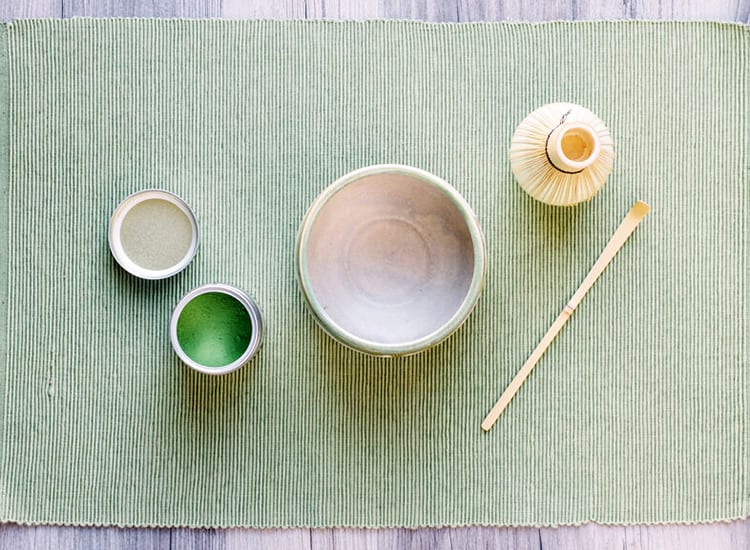Clean 21 Day Gut Health Cleanse
Our Signature 21-Day Full-Body Reset for Longevity
Questions? Ask about this product
Free Shipping On Orders Over $50
Complementary products


If you’re tired of visiting your local coffee shop to get your matcha tea every day, you can learn how to prepare matcha at home (and make it taste really great). With a handful of simple tips and tricks, you’ll know how to make matcha in no time.
The surge in matcha’s popularity seems to be forever growing and on the rise. This green-hued wonder ingredient has made its way to coffee shops and kitchens around the world. And for good reason.
In addition to its wildly vibrant green hue, matcha powder comes packed with antioxidants. Among these is a compound called L-theanine, which alleviates the energy crash brought on by the typical cup of coffee and instead, promotes a peaceful sense of calm alertness.
Traditional green tea is made from leaves that are steeped in hot water, whereas the matcha takes those leaves and grinds them into a green powder for the full range of nutritional benefits.
Read on to dive into the brain-boosting power of all things matcha.
If you’re making matcha at home with a bamboo whisk and tea bowl, the steps are simple.
First, sift 1-2 teaspoons of matcha powder into your bowl.
Add 2 ounces of hot water and whisk back and forth until the tea becomes frothy. We like to think of whisking in a zigzag or “W” shape, making sure no matcha gets stuck to the side of the mug.
Then — enjoy!
Although the steps are simple, knowing how to make matcha at home requires a bit of practice. If you’ve tried preparing matcha and found it to be bitter and frothy, you’re not alone. Many at-home matcha makers find the tea tough to make. Luckily, with a handful of simple tips, you’ll have the perfect matcha you’ve been searching for.
Brilliantly green, frothy and almost creamy in texture — these are the things that make the perfect matcha.
The Color
One of the first things people notice about matcha is the color. You want your matcha to be vibrantly green in color. This will come from using high-quality matcha that has been shade grown and is packed with chlorophyll.
No Clumps
When you’re learning how to prepare matcha, it’s important to note that the most perfect mugs or bowls of matcha have no clumps. Whisk until you achieve that perfect, clump-free consistency.
The Bubbles
In the best matcha, there will be very small bubbles — so small, in fact, that you almost can’t see them. Without big bubbles to distract, you’ll see only the finest matcha froth. If you do notice some big bubbles remaining, use the whisk to push them to the side so they’ll pop.
The Whisk
Traditional matcha is created with a chasen, a matcha whisk that’s made from bamboo. Although this isn’t completely necessary, it’s a small investment if you’re looking to create the best matcha with a good froth. As a general rule of thumb, the more tips the chasen has, the easier it will be to whisk and the more flexible the whisk, the better.
Electric mixers and milk frothers don’t usually have fine enough whisks to blend your matcha in the right way and give it that smooth layer of foam. But if you’re looking to make matcha tea without a whisk, they’re probably your best bet. You can also make your matcha by using the low-speed setting on your blender if you prefer.
Additional tip: When you get your whisk, let it air dry after cleaning it in hot water. You want to avoid putting it back into its container, or you run the risk of mold.
The Strainer
If you’re super serious about how to prepare matcha, you can also consider using a strainer. A strainer is an extra step to ensure that your matcha is free from clumps.
The Water
175°F is the recommended water temperature for matcha. You don’t want it boiling — instead, you want it to be near-boiling. Boiling water will make the matcha bitter, which you want to avoid.
The Brand
One of the most important things to remember if you’re wondering how to prepare matcha powder is to invest in high-quality matcha. Lower quality matcha might taste okay in baked goods and smoothies, but when you’re preparing tea — you want the real deal. Look for “ceremonial grade” matcha, which refers to high-quality matcha. Lower-grade matcha will often be listed as “culinary grade.”

Our ceremonial grade organic matcha green tea is 100% 1st harvest from Shizuoka Prefecture and Kagoshima Prefecture, Japan. It’s been shaded 3 weeks before harvesting to boosts chlorophyll levels and gives our bright green matcha increased antioxidants. Our matcha is perfect for use during our 21-Day Cleanse and can be enjoyed as a morning beverage or daily smoothie.
Ceremonial grade matcha is made from the youngest tea leaves that have been de-stemmed. It has a very smooth and vegetal flavor. It is the highest-quality tea selected for centuries in traditional Japanese tea ceremonies. The suggested serving size is 1g or 1/2 teaspoon, so this tin contains 30 servings.
When it comes to knowing how to make matcha at home, matcha recipes offer the chance for endless creativity. The unique taste of matcha, its health benefits, and its incredible color makes for a versatile and fun cooking ingredient.
For instance, this Vanilla Almond Matcha Latte combines the brain-boosting power of matcha with MCT oil for a warm morning drink. For a win-win, this latte provides sustained energy throughout the day and helps to keep you full.
Whip this up in the morning and enjoy the benefits throughout the day.